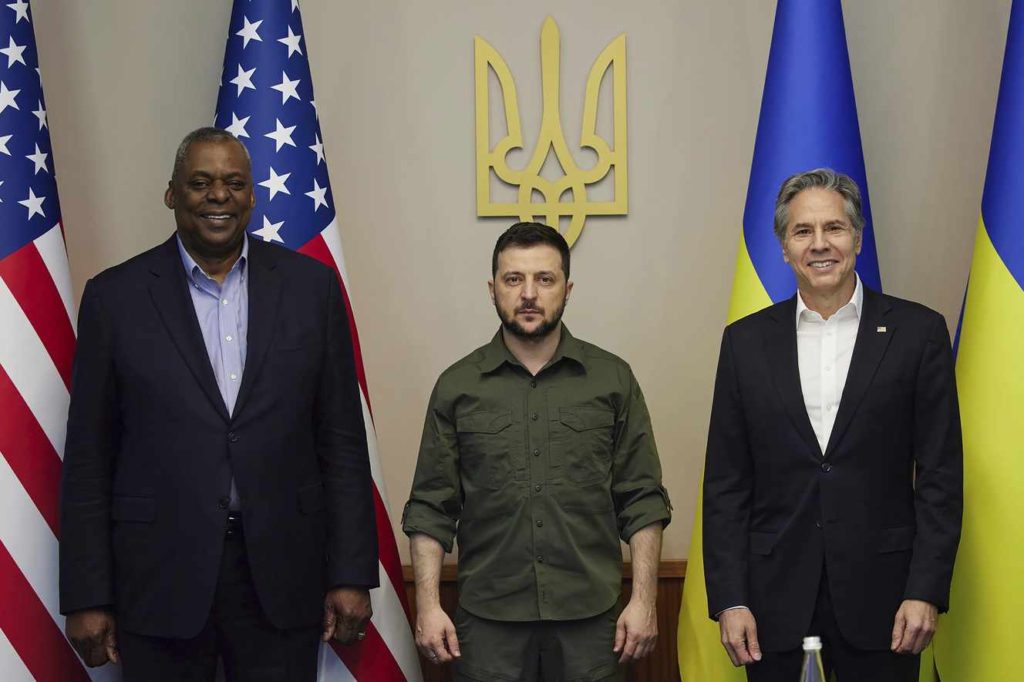While refusing to be labeled as cobelligerent, Washington is fully committed to supporting Kyiv, whether financially, militarily or with intelligence.
But to what end? For whose purpose?

ABOVE: From the left, U.S. Secretary of Defense Lloyd Austin, Ukrainian President Volodymyr Zelenskyy and US Secretary of State Antony Blinken pose for a picture during their meeting on Sunday, 24 April 2022, in Kyiv, Ukraine.
10 May 2022 – Way back in 2013 I wrote a short essay that identified the one thing – more than any other – that helps explain the way Americans see the world: their physical location. The United States is the only great power in the history of the world that has had the luxury of having nonpredatory neighbors to its north and south, and fish to its east and west. The two oceans to either side of the country are what U.S. historian Thomas Bailey brilliantly described as “its liquid assets”. Canadians, Mexicans, and fish. That trio of neighbors has given the United States an unprecedented degree of security, a huge margin for error in international affairs, and the luxury of largely unfettered development.
Obviously it can’t explain everything, to be sure. But it helps explain American pragmatism, idealism, arrogance and ambivalence. It’s in my essay.
The United States doesn’t have even the vaguest memory of anything like a modern total war. While World War II was a formative event in American history and Americans are rightly proud of their decisive role there, the human price they paid was small in the scheme of things: Romania suffered twice the combined military and civilian casualties of the United States, and never mind true carnage like the Soviet or German body counts (which were in the millions). America’s more recent wars, though of course devastating for many of those who served, were almost an outsourced affair that changed daily life for most Americans not one jot.
Because despite the shrinking nature of that world and the threats it carried – take the Pearl Harbor attack, the Cuban missile crisis, the 9/11 attacks – the United States never faced a threat to its existence. Its only real existential threat came not from abroad, but from within – a civil war over slavery that almost tore the country apart. Indeed, after the Confederate surrender at Appomattox, the United States would never again be faced with a threat quite like that. Unless you consider the present political and social polarization in the country. But again – that’s an attack from within.
The U.S. is involved in something like half a dozen conflicts at any given time, and most Americans can merrily live their lives without realizing it. Ah, the luxury.

ABOVE: Lviv, Ukraine high schoolers pack sandbags around two historic statues of lions, the city’s symbol.
The thought that American high schoolers would need to spend their Sundays singing patriotic songs while filling sandbags in preparation for bombardment is too fantastical to even serve as a fictional device. With a different history, the U.S. is more ambivalent about Ukraine. No longer willing to automatically shoulder global leadership in times of crisis, much of the American commentariat prefers instead to safely shadowbox Ukraine memes inside the Plato’s cave of Facebook and Linkedin and Twitter instead.
Part of the reason why the European reaction to the Ukraine situation has been so intense, apart from the obvious geographic proximity, is that the collective memory of what the Ukrainians are now enduring lives on in the European mind. Americans just see some unpleasant news in a country far away that most know little about; Europeans see echoes of their own recent history in today’s news and recognize a demon they thought they’d banished forever. Whether it’s Germans subconsciously pondering the Gedächtniskirche (a bombed-out Berlin church preserved as a ruined reminder) or even Spaniards recalling the aerial bombardments of their civil war (a trial run for World War Two), this Ukraine situation hits them at a visceral level.
Take perhaps the greatest tragedy in the Ukraine situation, the strategically-important coastal city of Mariupol. There, the Russian military indiscriminately fired into civilian areas, levelling block-after-block of residential housing, as well as encircling the city to subdue the populace via hunger and the winter cold. Russia destroyed the city with inhuman fanaticism. It’s no longer a war – it’s just revenge. A video from March:
ABOVE: filmed in Mariupol and posted by an OSINT contact
And far worse: the mass rape, summary execution and mutilation of Ukrainian civilians – the use of depravity and dehuminization to destroy Ukraine.
Plus the taking of hostages. The press is full of reports about the Russian “release of the civilians from the Mariupol Avos steel works”. But missing is the fact that most were not released to Ukrainian areas but to Russian controlled areas and Russia itself. This morning I read the report of retired UK Brigadier Alex Mackintosh who was directly involved in obtaining the release of those Mariupol civilians. These victims of war are safe but not free. It is important that the world doesn’t lose sight of where they are being held. Plus Moscow has deported over 500,000 Ukrainians to Russia over the last 8 weeks, to multiple locations across Russia. Almost all unaccounted for except for a few who managed to secure mobile phones to report locations.
All of this is beyond the comprehension of most Americans. I am now back in Krakow, Poland with my team, two of them just returned from the Ukraine killing fields. I will have a full report in the coming days on the mass rape, summary execution and mutilation of Ukrainian civilians. It will be based not only on our work covering this war, but also on my work investigating Yugoslavian war crimes – including massacres, ethnic cleansing, systematic rape, and crimes against humanity – and my 5 year study of genocide, mass violence and dehumanization for my upcoming films on these same topics.
I do not think America will “re-learn” any great lessons about the way the world works, that great oceans (or more contemporaneously, screens full of Twitter memes about the conflict) only distance you from so much. No, that will not happen. They will never understand that what is happening in Ukraine and Russia – or Chechnya or Rwanda or Syria or Yemen or 100 other places – is the real world. Because America has lost the ability for conceptual historical thinking. Its citizens don’t study history, only celebrity and wealth and professional success – prized in its society. Experts in various domains of knowledge are now considered to be “elites” and “not to be trusted ” by the average person. It’s the decline of most of the West, not just America, and it’s happening in real time, right before our eyes.
Because America is fortunate that it can live in “The Matrix” (well, a somewhat brutal “Matrix” given its political and societal system has atrophied). Still, it is removed from the reality of the world. It’s so surreal how we’re closer to nuclear war than we’ve been since the Cuban Missile Crisis (U.S. military planners know Russia has “red teamed” the use of tactical nuclear weapons), and the current situation will continue to escalate. Yet hardly anyone seems to notice and almost everyone is just going about their lives thinking their usual thoughts and having their usual conversations.
Yet America still seems to be caught up in the euphoria of a proxy war against Russia.

Waging war by proxy without losing soldiers is a strategy which is not without risk. The U.S. commitment to Ukraine is now well established. Jill Biden’s surprise visit to the country on Sunday, 8 May was a symbolic demonstration of this. The wife of the American president met with the wife of Zelensky in the town of Uzhhorod, near the Slovak border. But behind the political gestures and the regular announcements of new U.S. deliveries of materiel, there is also an invisible war. The general public is not aware of the extent of intelligence sharing with Ukraine. For several months, thanks to its technological capabilities, the Pentagon has helped protect Ukrainian forces from enemy fire and has helped them target Russian positions. I was able to attend an off-the-record briefing at NATO on how that works. A series of stories in The Guardian, The New York Time and the Washington Post (summarised here) pretty much cover what I learned at that briefing.
Washington refuses to be labeled as cobelligerent. However, the distinction has become increasingly blurred. Would the Moskva, flagship of the Russian fleet, have been sunk without American intelligence? The Neptune missile was certainly fired by the Ukrainians, inflicting a humiliating loss on the Russian forces. But on 6 May the Washington Post reported that this success would not have been possible without prior input by the United States. What kind of input? Official obfuscation. Defense Department spokesperson John Kirby:
“Ukraine combines the information we and others supply with intelligence they gather themselves, and they make their own decisions”.
On 5 May Kirby responded to another revelation by the New York Times. According to the newspaper, the U.S. military has helped locate and kill a dozen Russian generals. A spectacular number. In Washington, the National Security Council said the New York Times presentation was “irresponsible” and misleading, claiming that the United States would not provide any information on the movement of Russian top brass. Which is counter to what I learned when I was researching my sniper article which was that U.S. military training and intelligence were both very much involved.
The sometimes surprising enthusiasm of Joe Biden
This series of revelations is not evoking a unanimous response. It has the appearance of a peacock strut, with the risk of aggravating Russian exasperation. Biden even had to rein in the heads of the services concerned and the military. Whether coordinated or spontaneous, it reveals an undeniable euphoria that has gripped part of the “blob,” the nickname given to the small circle of foreign policy experts with shared views that cross partisan lines. Russia’s war on Ukraine is a very clear case in moral terms, with an aggressor and a victim. But this fact and the increase in supplies of military equipment to Kyiv ($3.7 billion and counting) do not silence questions about American strategy.
“Helping Ukraine to defend itself” is a slogan with many possible interpretations. The proof is that what seemed impossible two months ago is now possible. A dramatic example is that the US Army organized training sessions in Germany for nearly 200 Ukrainian soldiers, to teach them to operate the M-777 howitzer. A hundred of these pieces of artillery, together with their 155 mm ammunition, have already been sent to Ukraine to participate in the battle for Donbas.
This development is also reflected in the rhetoric. Biden has shown sometimes surprising enthusiasm, between personal conviction and spontaneity. During his visit to Warsaw on 26 March, he said that Vladimir Putin “cannot remain in power.” The same evening, his advisors rejected the idea of a secret desire for regime change in Russia. But since then, US officials have maintained a pose of ambiguity. At the end of his trip to Kyiv, Secretary of Defense Austin explained that the goal from now on was “to see Russia weakened to the point where it couldn’t do the things it did when it invaded Ukraine.”
It is logical to be pessimistic about the chances of a negotiated solution and a ceasefire at this stage of the war, when the lines are not stabilized and the full extent of Russian crimes is becoming apparent. But unlike the Europeans, the United States is not even talking about a necessary diplomatic outcome in two months or two years. Which explains the rhetorical overkill, the repeated use of the word “pariah” to describe Russia, the desire to step up economic sanctions.
How much support, and for how long?
On 28 April, when presenting his request to Congress for a one-time $33 billion budget increase, Biden explained that ”investing in Ukraine’s freedom and security is a small price to pay to punish Russian aggression, and lower the risk of future conflict.” A few days later, the U.S. president visited the Lockheed Martin arms factory in Alabama. There, he put the support to the Ukrainians in a broader geopolitical and existential framework. “There is a battle going on in the world between autocracy and democracy,” Biden said. General Mark Milley, Chief of the Joint Chiefs of Staff, explained on CNN on 26 April “What is at stake is the international order that was established in 1945”. So, what is the ultimate goal of American support for Ukraine? How far, and for how long?
American officials hide behind the sovereignty of Ukraine, the victim of the aggression. It will be up to Ukraine to define the terms of a political agreement and any territorial concessions. But as the symbolic victories accumulate, and the rout of the Russian army becomes increasingly apparent, there is a growing temptation to continue the fighting, despite the human and material cost. The notion is taking hold of a shining hope and a historic opportunity to emasculate Russia militarily in the long term. As I have noted in previous posts, the mindset is “We’ll continuing fighting Russia until the last Ukrainian”.
Talk of victory and weakening Russia is alarming. As many military analysts have noted, the current discussion is focused on Ukrainian needs – more Stinger and Javelin missiles, ammunition and drones. But we are not hearing much about the goals of the war. Where is it going? Now, NATO is discussing this, internally and with the Ukrainians. In an ideal world, Ukraine would take back all of Crimea and Donbas. But the issue is … is that really feasible and strategically wise? Or is it incredibly dangerous, raising the risk of escalation?
At present, such concerns are almost invisible in the American debate. At present, the outcome of a stable state is unimaginable. Ukraine is not “winning”. It is being handed a devastated state. According to a preliminary report issued by the World Bank last week, even if the war stopped today, Ukraine’s economy would contract by 45.1 percent in 2022, and the Kyiv School of Economics put the country’s total economic losses at up to $600 billion so far. While the EU has allowed four million Ukrainian refugees to stay, to work, to send their children to school, and to bring their pets, with every day that passes more and more of them will put down roots and never return. Destroying a country means more than just demolishing buildings and murdering people.
It will be a long war requiring a long strategy. And I know it’s heretical, but Ukraine’s end goals and the U.S. end goals are not necessarily aligned. At the end of that meeting between Austin, Zelenskyy and Blinken pictured at the top of this post they and the leaders of the G7 countries unanimously expressed their “unwavering support” for Ukraine’s struggle for a “prosperous and democratic future within its internationally recognized borders.” The closing wording implies Crimea and Donbas as a whole. At whatever the cost.
